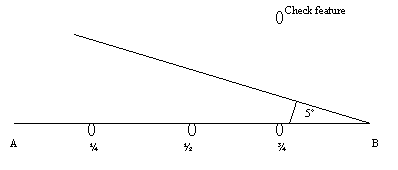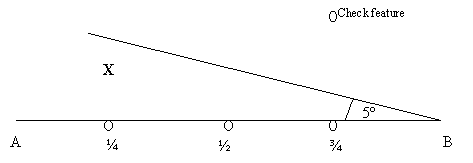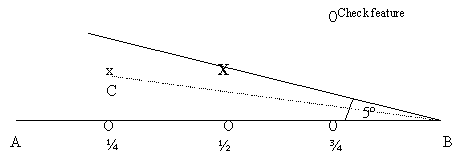| Theory for NTR | Page Summary | Back to Nav Techniques |
New Track Reference Technique
The New Track Reference Technique is based on the 1 in 60 rule. Simply put, if you are 60 miles from a point and 1 mile off track (in other words a cross track error of 1 mile) the closing angle is 1 degree. See the diagram below:

From the rule:
If you are 1 mile off track at 30 Nm you would be 2 miles off at 60 Nm and therefore the error or closing angle is 2 degrees,or 5 miles off track at 20 = 15º (as 20 x 3 = 60 and therefore 5 x 3 = closing angle).
The New Track Reference Technique uses the assessment of the change in closing angle to calculate a new track to fly to the destination. In the previous paragraph we saw how we could calculate the closing angle using the 1 in 60 rule but it is much easier to draw a reference line at, say, 5º and thus the New Track Reference Technique starts in the planning stages.
First: Draw
the route "A" to "B".
Second: Choose
track check features at easy intervals along the route ie ½, ¼, ? intervals
along the route – we will discuss how to choose features in more depth in the
article on medium level navigation planning.
Third: Draw
a 5º drift line downwind from the destination point "B".
You should end up with a plan like this one below:

Flying the Plan
As we set off from "A" we fly the heading for our desired track until we get to our first check feature. We mark on the diagram our position, taken from the ground outside, at the fix (X).
We can see from our fix that, relative to our 5o line our closing angle has changed from zero (on track at start) to 3o.
Using the estimate of cross track error from the drift line and the 1 in 60 rule, we can see that:
If "AB" =120 Nm then:
The required heading change is the track error plus the closing angle.
Change of heading = 1.5 x 3º x 60 + 1.5 x 3º
x60
¼AB ¾AB
=
4.5 x 60 + 4.5 X 60 = 12º right or starboard
30 90
Put simply ..
As we are 90 Nm from "B" and 3o off track we are 1.5 (90 Nm is 1.5 x 60) x 3 Nm off track = 4.5 Nm.
Therefore we know that:
- The required track correction is the closing angle plus track error.
- The closing angle off the map is 3o.
- The cross track error is 4.5 Nm.
- As we have flown 4.5 Nm off track in 30 Nm flown from "A", the track error is 2 x 4.5 = 9.
- The heading change required is 9o plus closing angle of 3 = 12o.
This can be further simplified in our technique as it also equates to the change in closing angle x 1 over the proportion of track flown.
Change in closing angle = 3 x 1 = 3 x 4 = 12º right
or starboard. If the next fix places the aircraft at X
in the next figure:
¼
We have now established a New Track "C" to "B".
therefore we use the change in closing angle and refer to a new track distance.
Therefore...

The change in closing angle is from 3º to 5º = 2º and the proportion of new track flown ("CB") is ? ... thats right a third and therefore the change in heading required is 6º right or starboard and so on..